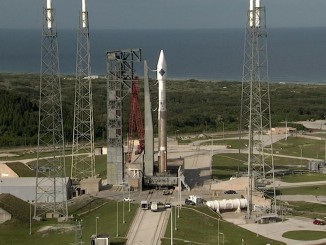
CAPE CANAVERAL — Hobbyists who keep track of the skies with remarkable precision have found the U.S. Air Force’s mini space shuttle in its no-longer-secret orbit around the Earth.
The X-37B craft, making the program’s fourth mission into space, was launched May 20 from Cape Canaveral atop a United Launch Alliance Atlas 5 rocket.
The ascent entered a news blackout about five minutes after liftoff, as the Centaur upper stage began its burn to put the spaceplane into low-Earth orbit.
It wasn’t until later that officials confirmed the launch had gone smoothly for the Orbital Test Vehicle mission No. 4. It is believed the Centaur deployed X-37B about 19 minutes into flight.
Observers this week spotted the craft flying overhead in a 194 by 202 mile orbit (312 X 325 km), tilted 38 degrees relative to the equator.
That perch is lower than previous X-37B missions and the inclination is lower, too.
“OTV 4 entered the lowest initial altitude of the program,” said Ted Molczan, a respected satellite observing hobbyist.
“The ground track nearly repeats every 2 days. Frequently repeating ground tracks have been a common feature of the program. This could be an indication of a surveillance mission, or it may offer some operational advantage I have yet to figure out.”
Although the Air Force revealed two experiments to be conducted on this fourth mission — an electric propulsion thruster test and materials exposure in the space environment — much was classified about the flight, including the orbit, mission duration and even which of the two X-37B spaceplanes is making the trip.
“The X-37B testbed platform is unique because we can tailor to specific user needs and return experiments back to post-flight inspection,” said Ken Torok, Boeing’s director of experimental systems.
“Reliability, reusability and responsiveness of the X-37B will fundamentally change how we perform future space missions.”
OTV 1 (first flight of Vehicle No. 1)
Launch: April 22, 2010
Landing: Dec. 3 2010
Duration: 224 days
OTV 2 (first flight of Vehicle No. 2)
Launch: March 5, 2011
Landing: June 16, 2012
Duration: 469 days
OTV 3 (second flight of Vehicle No. 1)
Launch: Dec. 11, 2012
Landing: Oct. 17, 2014
Duration: 675 days
“These missions have proven the reliability and flexibility of the system to support a variety of experiments,” Torok said.
See our earlier launch coverage.



